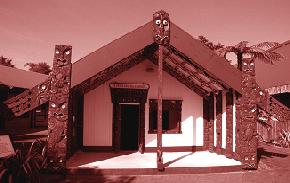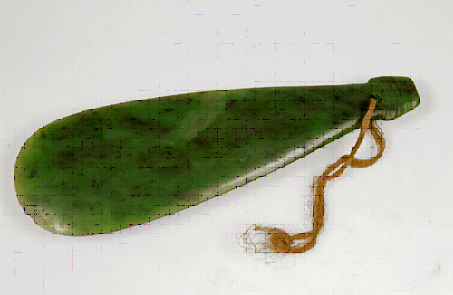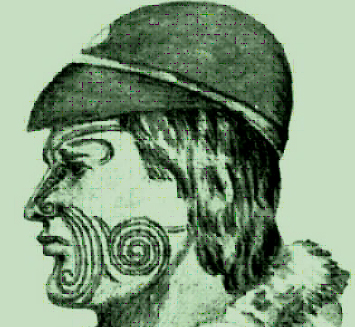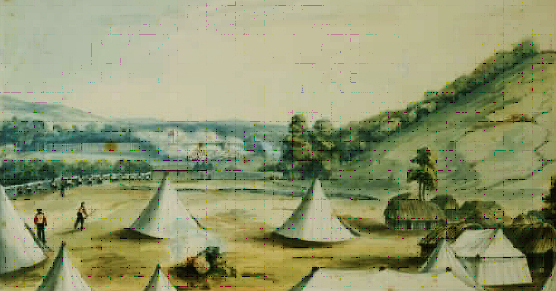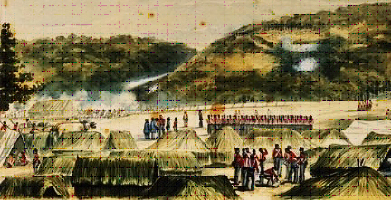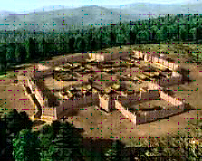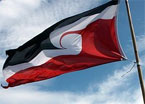“In an English fort the ditch is deep, and outside the defences; in a New Zealand pa the ditch is shallow, and inside the palisades. In an English fort, the ditch is made to obstruct the enemy; in a New Zealand pa the ditch is made to cover the defenders, who stand in it and fire at the besiegers”.
Arthur S Thompson, Surgeon-Major 58th Regiment (1859).
On the 11th of January 1846, about 20 kilometres from the township of Russell, British soldiers entered the Bats Nest; a fortification belonging to New Zealand chieftain Te Ruki Kawiti. Non-European fortifications in New Zealand were more commonly called pa and had always been a part of ancient warfare but the aptly named Bats Nest was no ordinary pa. Within its four meter high palisades lay a labyrinth of reinforced tunnels bunkers and trenches. The Bats Nest was Kawiti’s response to Britain’s heavy artillery but it was not the first time he had built a fortification consisting of trenches and bunkers. A similar fortification had been built eight months earlier to fight Britain’s 58th regiment. The Bats Nest, however, was Kawiti’s magnum opus; an engineering marvel that so impressed the British, they made not one but two models of it.
A Moral & Technological Revolution (1770-1840)
The great British philosopher and economist John Stuart Mill once wrote that; “there is no nation which does not need to borrow from others, not merely particular arts or practices, but essential points of character ”. New Zealand was one of those nations that John Stuart Mill had in mind. In the 60 years prior to colonisation, European and native New Zealanders where greatly advantaged by “borrowing from one another”. Trade had developed naturally, with Maori providing food, shelter and transport in return for European goods. By the late 18th Century Maori were regularly visiting Australian ports and doing business in either Sydney or Melbourne. In 1774, an Australian newspaper commented on how “extremely shrewd in making bargains” they had become and by 1833, their image was summed up by one local as “industrious, intelligent, bold, and enterprising ”.
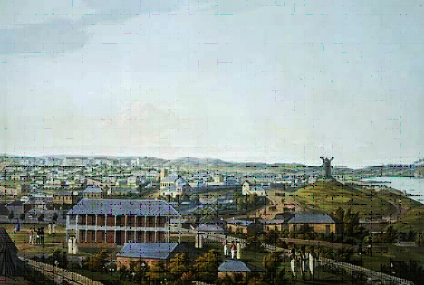
“The town of Sydney in New South Wales”. Maori became involved in timber and flax trading ventures, and also visited Sydney. This 1823 aquatint shows cloaked Maori chiefs standing in a Sydney villa © National Library of Australia
It was during the late 18th and early 19th century that these first ‘chiefs of industry’ travelled the world. Their old-world forays began on American and European vessels in return for income and passage to foreign places . Some became shipmates and officers while others chose to settle permanently overseas. However, most returned home and brought with them a wealth of overseas experience which helped to establish a diverse range of Maori-owned industries. These industries included flour mills, shipping lines, market gardens, tree milling, gum mining, and as a precursor to today’s staple – the nation’s first commercial dairy farm . Some continued to travel overseas, mainly to Australia, in search of new export opportunities and by the mid eighteen hundreds, Maori-owned trading ships plied the coast of New Zealand. Hazel Petrie, in her outstanding analysis of pre-colonial industry, notes that by:
“Using a range of commercial strategies, Maori had captured a considerable volume of trade and a healthy surplus of exports over imports by 1840 ”.

Maori Trading Vessels: In the first half of the 19th century, Maori entrepreneurs owned more than 15 schooners, similar to the type pictured. Mr Pi of Hokianga was the first Maori businessman to purchase a schooner – the Emma (Renamed the Taeopa) in 1831 from a Sydney vendor for about £500 (Petrie, 2006)
It was also a combination of travel and trade throughout the early eighteen hundreds that enabled them to acquire muskets and to reorganise their own military tactics with devastating effect. Muskets were imported from as far as England, thus sparking off what has been described as; “a series of savage civil wars ”. Indeed, these wars may have claimed up to 80,000 lives over a 10 year period – more New Zealand lives than any war has claimed since. Nonetheless, the Musket Wars, as they came to be called, were not just a by-product of travel and trade. They were part of the same sequence of “borrowing” and adaptation that had first started at the end of the 18th Century – more than 50 years prior to colonisation.

Raniera Te Hiahia Heavily tattooed Maori warriors were not only quick to adopt muskets but also European clothing. This sketch by Major-General Robley is of Raniera Te Hiahia, a Maori scout from Tauranga ©New Zealand Electronic Text Centre
While travel and trade reshaped the way in which pre-colonial Maori did business, the musket reshaped the way in which they conducted warfare. Old weapons became redundant, arm-to-arm combat became less effective, and the pa began its transformation from an ancient fortification to a modern defence system capable of withstanding musket fire . But it was the rationale for war which was largely reshaped. The huge loss of life which followed these wars made fighting morally untenable and by the early eighteen thirties, competition had all but moved from the battlefield to the market-place as commerce and commonsense took over.
The period 1770 to 1840 has been called; “a moral and technological revolution ”, smaller in scale but more comprehensive than that experienced in Europe. Indeed, this revolution may have been the most rapid “borrowing” of innovations, ideas and technology ever made by a single culture. By the mid eighteen hundreds, Maori were no less versed in commerce, Christianity and modern warfare than their pakeha (non-Maori) counterparts. Furthermore, in the absence of any formal laws or government, economic and social relations between the two races was exceptional and for the most part, they lived together in harmony as they forged ahead with a distinctly New Zealand identity. It will never be known for certain how the country would have developed had it not become a colony of Great Britain, however:
“The achievements of the pre-1840 period, in economic development, race relations, and social controls were considerable. Divisions based on race, class, and sect would have had little meaning ”.

Standing Together Maori timber workers stand with Europeans outside an early water-powered sawmill. In the first half of the 19th century, the Maori controlled the timber trade in their tribal areas. Kai Warrawarra Saw Mill. Drawn by SC Brees. Engraved by Henry Melville. London 1847. Permission of the Alexander Turnbull Library, Wellington, New Zealand, must be obtained before any re-use of this image. Reference: A-109-033
Te Whare Wananga mo nga Tohunga – The House of Learning
Te Ruki Kawiti was born at the beginning of this moral and technological revolution, somewhere around 1774. His father Huna and mother Te Tawai belonged to the Ngati Hine hapu or clan situated near the town of Kawakawa. The Ngati Hine hapu is part of the much larger Ngapuhi tribe and the Kawiti family are direct descendents of the tribe’s first leader, Nukutawhiti, who was also captain of the tribes’ main waka (Outrigger). This waka landed at Hokianga in the Bay of Islands and is said to have been part of a large group of Waka that migrated from Eastern Polynesia during the late 13th Century.
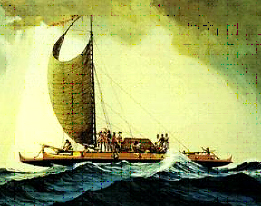
The Waka: The Polynesian people who were to become New Zealand Maori discovered and settled New Zealand between the 12th and 13th century. Maori oral history tells that they sailed to Aotearoa [New Zealand
Although details of Kawiti’s childhood are sketchy, it is known that as a young man he was admitted into his tribe’s Te Whare Wananga mo nga Tohunga or House of Learning. It was an exclusive learning institute for gifted young men who were earmarked to become Tohunga – experts in warfare, negotiation, the arts, and genealogy to name a few. Tohunga had an almost intuitive quality and Kawiti was no exception but like the other young men attending this institute, he would have been chosen because of his sharp mind and retentive memory; the two main criteria for admittance into a Te Whare Wananga.
During the early eighteen hundreds, Kawiti found himself fighting alongside Oceania’s first practitioner of musket warfare, his distant relative and contemporary Hongi Hika. He first joined Hika at the Battle of Moremunui, a seagulls feast; a battle which marked the beginning of musket warfare in this part of the world. During this time he accompanied him on several expeditions, thus gaining valuable experience in fort construction and modern warfare tactics. Indeed, by the middle of the 19th century, he had accumulated more than a decade of musket warfare knowledge and was able to proclaim with some confidence that:
“I know all about all sorts of guns; all guns will kill, and all guns will also miss; this is the nature of guns ”
A Beautiful Greenstone Mere
Kawiti’s experience in modern warfare tactics might well have seemed wasted by the early eighteen forties. He was, after all, nearly 70 years of age and the “savage civil wars” which were so much a part of his generation had all but ended with Hika’s death more than a decade earlier . But on the 20th of January 1845, he received an unexpected visitor – Hone Pokai Heke, a young chief who had business ventures in the bustling South Sea port of Kororareka (Russell, Bay of Islands), entered his home carrying an ornately wrapped gift. Somewhat puzzled, Kawiti began to unwrap it in the presence of equally bemused onlookers in what was to become a defining moment;
The ornamental mere or club symbolised Maori culture and authority whereas the excrement was the insult being heaped upon it by the British. Kawiti did not really need an excuse to help Heke fight the British. The warrior-blood still stirred in his old veins but more importantly, he greatly resented Britain’s presence in New Zealand and had been opposed to the Treaty of Waitangi, an agreement which Heke and other Maori had signed in 1840. At the time, he had predicted (somewhat prophetically) that the treaty would erode Maori autonomy and during a pre-treaty meeting, he told the British delegation in no uncertain terms to:“The contents were discovered to be a beautiful greenstone mere… smeared in human filth. No words were spoken, but to the alert mind of Kawiti, the significance of the suggestion was at once apparent. And when at last he gave voice to his feelings he said to Heke: ‘You may return home. Your desire will be gratified. I will speak to my people’. From that moment the die was cast. His mind was made up, and he began the immediate mobilisation of his forces ”.
“Go back. What do you want here? We do not want to be tied up and trodden down. We are free. Let the missionaries remain but as for you, return to your own country. I will not say ‘yes’ to you ”
A Precondition that would Reverberate through New Zealand History
The British did not “go back”. Lord Normanby (Secretary of state for the Colonies) had received numerous “reports” from a variety of sources including Britain’s official resident in New Zealand, James Busby. These reports are no longer given much credence but at the time they described an alarming situation where the country was literally being overrun by “persons of bad or doubtful character ”. These persons were said to be “the authors and victims of every species of crime” and as far as Normanby was concerned, Maori and respectable British settlers needed to be “rescued” from “a lawless state ” This task was given to Captain William Hobson who was instructed to annex either all or part of the country but with one important proviso – a precondition that would reverberate through New Zealand history. The “free intelligent consent” of Maori would be needed. While this was a huge departure from what had occurred in other parts of the world, it was hardly surprising. Britain had already endorsed New Zealand’s original flag and its 1835 Declaration of Independence; Maori had developed both socially and economically in the absence of any outside power; and the rights of indigenous people had become an important issue – an issue that was clearly evident in Normanby’s instructions to Hobson:
“I have already stated that we acknowledge New Zealand as a sovereign and independent state”. “The admission of their [indigenous] rights is binding. The Queen, in common with her majesty’s predecessor, disclaims for herself and her subjects every pretension to seize on the Islands of New Zealand or to govern them as a part of the Dominions of Great Britain unless the free intelligent consent of the natives shall first be obtained ”.

The New Zealand Flag as it was at the time of the country’s 1835 “Declaration of Independence”. United Tribes Ensign. James Laurenson Papers [1834-1845
The free intelligent consent of the “natives” was obtained and out of Normanby’s instructions came one of the most forward-thinking and yet contentious pacts in colonial history. The 1840 Treaty of Waitangi, as it came to be called, was signed by more than 500 Maori in anticipation of a whole raft of benefits. These benefits included the “sharing of authority”, “protection from acquisition by other foreign powers” (i.e., France), a British governor “who would control [lawless] Europeans”, an increase in settlement, and “more markets” for Maori goods and services . But by 1845 few if any of these benefits were being enjoyed, and Heke, more than any other Maori leader, was feeling the ill-effects of an administration that was becoming increasingly one-sided.
The Treaty of Waitangi
For Hone Heke, the 1840 Treaty of Waitangi had not so much turned to custard but “soap”. It was, according to Heke; “very smooth and oily on the outside but treachery was hidden under it ”. Heke was hurting and he probably had every reason to feel aggrieved. He had been the first person to sign the treaty and like many indigenous New Zealanders, he believed that it would augment his burgeoning business empire by attracting more Pakeha. However, increasingly, the British administration began to call the shots and before long he was prohibited from felling timber, collecting taxes and charging port fees. Furthermore, without consulting him, the British moved the country’s capital from the Bay of Islands to Auckland, thus greatly reducing the amount of revenue coming into the town – and into Heke’s pocket!
Heke was not only smarting over a loss of revenue but also a loss of authority. Increasingly, the British administration were taking matters into their own hands and rarely if ever consulting him or his people. Indeed, this imperialistic attitude peaked when the local constabulary decided to arrest, charge, and later hang a young man by the name of Maketu. After these events, Heke began to nurse a considerable amount of “wrath”. They had, according to one observer; “not only robbed him of his dignity and his revenue, but now claimed the right of life and death over his countrymen ”. It was indeed a turning point but in seeking Kawiti’s help, Heke was about to awaken a shadowy figure from the past; a man who had his own agenda and whose military genius would take everybody by surprise.
Poroporoa i nga Ringa-ringa me nga Waewae
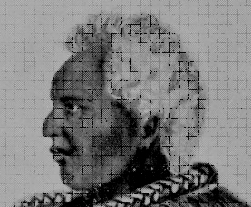
A rare life-like picture of Kawiti who would have overseen most battles wearing a traditional chief’s cloak Artist unknown. Based on a painting by J .J Merrett. Permission of the Alexander Turnbull Library, Wellington, New Zealand, must be obtained before any re-use of this image. Ref: 1/2-037353
Heke wanted to cut down the symbol of British authority for a fourth time – the Union Jack flying above the township of Kororareka (Russell). It had become the object of his “wrath” and with more than just a little provocation from local American’s, he had come to believe that it represented slavery. However, he had no intention of harming the town or its many settlers and from all accounts, he was in favour of more pakeha. But Kawiti was of an entirely different ilk. He was of an older generation; a tohunga and military man who cared little for trade and even less for settlement. So when Heke told him of his plans, the older man replied:
“Poroporoa i nga ringa-ringa me nga waewae ”, meaning cut off the hands and legs!.
Cutting off the “hands and legs” amounted to destroying Kororareka. It was a suggestion that probably caused Heke some grief but he was in no position to question Kawiti. The older man was a revered tohunga and a senior Ngapuhi figure – far more senior than Heke. Indeed, he was not only a veteran of the “savage civil wars” but also a contemporary of Heke’s father-in-law, the great Hongi Hika. As such, he wielded far more authority than the younger man and as already noted, having invoked him with such a potent symbol, the die was now well and truly cast.
Kororareka: The Fall of a Capital
Kawiti’s plan was simple but brilliant. His men would attack the town, thus diverting attention away from Heke’s men who would then scale Maiki hill and cut down the British symbol for a fourth and final time. The town and flagstaff were heavily guarded by British troops but this did not deter the old tohunga and on the 10th of March 1845, he launched his attack on the former capital with the sort of leadership equal to any of the world’s greatest generals. The initial thrust of Kawiti’s attack was described by eye-witness Frederick Maning:
“In the morning, before it was light, Kawiti rushed upon Kororareka [and his] young men did not look for the light in this world; their only thought was who should kill the first [English] man and elevate his name ”.
On the night before the fight, it is said that Kawiti undertook an ancient ritual in order to intuit the outcome of the battle. He threw four rakau or “darts” – one for himself, one for his men, one for the British, and another for the town itself. According to “Old New Zealand” custom , when a rakau travels accurately, it is a sign of bravery and success but when it turns wrong side up, it is an omen of death. Indeed, all four r?kau travelled “straight and fair” but the one belonging to Kawiti and the one thrown for his men landed “wrong side up”. Turning to address his troops, Kawiti said:
“It is good! Here have I two darts ominous of success and bravery, and death – our enemy will prove very strong and brave, they will suffer much from us, and so will we from them. I am not displeased, for this is war and not play ”
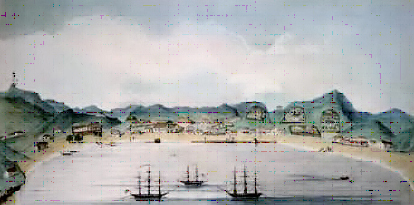
Kororareka, Bay of Islands. Sketched Mar 10th, 1845, on the morning before its assault and destruction. Drawn by George Clayton, on stone by W. A. Nicholas. London, E. D. Barlow [1845?
Kawiti’s forces did indeed “suffer much” and the great warlord himself was struck-down “wrong side up” by the loss of his son. However, both Kawiti and Heke were successful in accomplishing what they had set out to do. The British flag was removed and more importantly, “the hands and legs” were cut off! In fact, the carnage inflicted on Kororareka, the site of New Zealand’s first capital, was so immense that most of the townsfolk had to be evacuated by ships to Auckland. One of the last ships to leave port on that day was the “Hazard”; an 18-gun British warship which fired on the town in a vain attempt to exact some revenge. W.T. Bainbridge was in Auckland when the Hazard and other ships arrived:
“They [the British] appeared disappointed and dejected. They came by the Hazard soon after the fight. The other man-of-war was the St. Louis, of the United States. The Hazard had her wounded captain on board, and the English whaler, the Matilda, was crowded with people ”
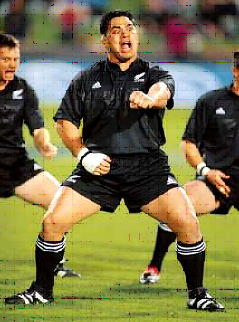
A glimpse into the Past The New Zealand “All Blacks” squat low to the ground in a defensive stance prior to performing the traditional pre-match Haka. (War dance). The stance is similar to that used by many Asian martial arts. It harks back to an earlier time when Maori fighters girded themselves in preparation for arm-to-arm combat. The stance is part of Mau r?kau: a Maori martial art taught in early Te Whare Wananga or ‘House’s of Learning”, of the type Kawiti had attended as a young man.
During the Battle of Kororareka, an eyewitness by the name of Mikaera Rini tells of how a British officer was confronted by an old man . Unaware of the old man’s pedigree, the officer drew his sword with the intention of dispatching him quickly. A number of younger fighters rushed to the old man’s aid but in a calm voice he said; “E te whanau, tukua mai ki ahua”, meaning; “My people, leave him to come to me”. The old man squatted low to the ground, and had the officer known how invulnerable an old warrior is in this position, he might not have rushed at him so carelessly. Within the blinking of an eye, the officer was thrown to the ground and dispatched with the old man’s mere –the old man was Te Ruki Kawiti!
Puketutu: a Bitter Lesson in Strategy
It took the British about two months to regroup – another warship arrived and more than 400 troops assembled at the Bay of Islands. Unbeknown to all, “The New Zealand Wars” had begun and the nation was about to be plunged into years of prolonged conflict . Bitter from their defeat at Kororareka, Lieutenant-Colonel William Hulme launched an attack against one of Heke’s fortifications at a place called Puketutu. His goal was to destroy this newly built pa and more importantly, capture its ‘rebel leader’. Indeed, had it not been for Kawiti, he might have succeeded. However, by remaining outside of the pa, Kawiti’s fighters were able to intervene whenever the British looked likely to breach its defences. As described by one eyewitness, Heke shouted to his men:
“Now let every man defend the spot he stands on, and think of no other’. And as he was saying this, the [British] soldiers and sailors had begun to move towards the pa, when ‘suddenly’ Kawiti with one hundred and forty men appeared close upon their right, and fired upon them. Then the soldiers turned quickly to their right and attacked Kawiti ”.
By battles end, the pa remained intact, its ‘rebel leader’ remained free and for whatever reason, the highly experienced Lieutenant-Colonel William Hulme suddenly called off the attack.

On the 8th May,1845. Marines & Sailors of H. M. Ships North Star and Hazard against the combined forces of the rebels Heke & Kawiti / C. Bridge. Permission of the Alexander Turnbull Library, Wellington, New Zealand, must be obtained before any re-use of this image. Reference number: A-079-008
Although Hulme was unable to destroy the pa or capture it’s ‘rebel leader’, a large number of Kawiti’s fighters were either killed or maimed trying to stave off the attack. According to one eyewitness; “twenty of Kawiti’s men were slain” and one of them happened to be his son, “the second son he had lost in the war ”. The combination of musket and bayonet proved far superior to that of musket and mere and as is often the case in war, the Battle of Puketutu ended up serving as a bitter lesson in strategy. Kawiti would never again try to engage the British in open warfare, despite this being his preferred mode of fighting. Instead, he would turn his attention to a new and ingenious strategy.
Ohaeawai: A Possible World First in Military Engineering
After the Battle of Puketutu, Kawiti and Heke’s forces went their separate ways. While Heke confronted Maori forces allied with the British at “Te Ahu-ahu”, Kawiti began making modifications to an existing pa at a place called “Ohaeawai”. The Ohaeawai fortification would not only include features gleaned from years of musket warfare experience but also ingenious innovations to counter Britain’s heavy artillery. Indeed, these innovations would place Kawiti at the forefront of modern fortification construction, thus making Ohaeawai a model for all future Maori defensive systems .
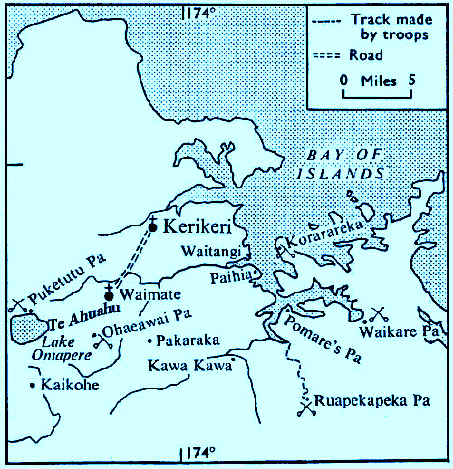
This early eighteen forties map marks the first battles of the “New Zealand Wars” (swords). Te Ahuahu is about halfway between Puketutu and Ohaeawai. Kawiti’s home was near Kawakawa. Kororareka, present day Russell, is also clearly marked. The 1840 treaty was signed across the Bay at Waitangi – hence the “Treaty of Waitangi”. The only road at the time was between the Kerikeri and Waimate mission stations which are marked by crosses. ©Te Ara – the Encyclopaedia of New Zealand.
The Ohaeawai fortification was completed on the 23rd of June 1845, just one day before Colonel Henry Despard arrived with a contingent of about 600 troops. Made up largely of men from the 58th and 99th regiments, this contingent was equipped with weaponry that included several cannons, rockets, and a massive 32-pound gun. Conversely, Kawiti had somewhat older muskets, four small cannons, and about 100 men at his disposal. Inside the pa his men were under the command of various Ngapuhi chiefs, including the venerable Haupokeha who delivered a series of stirring speeches. In one these speeches he implored his young fighters to; “wait patiently for the enemy to walk into the oven ”, thus alluding to what Kawiti had in store for them.
By the 1st of July 1845 the British had fired more than 400 cannon-shots into the pa, including a number of rounds from their massive 32-pounder. Confident that Kawiti had suffered a ‘severe loss’, Despard ordered 250 of his best troops to make a final assault. His decision to attack the pa however would turn out to be a grave error in judgement – a decision that would cost him his reputation as a competent Colonel and raise Kawiti’s star to the status of local folk hero. As described by Lieutenant W. H. Free of the 58th Regiment, the British assault party soon found themselves in a one-sided fight:
“When we were within fifty paces, the whole front of the pa flashed fire, and in a moment we were in a one-sided fight – gun flashes from the foot of the stockade and from loopholes higher up, smoke half-hiding the pa from us, yells and cheers, and men falling all round ”.
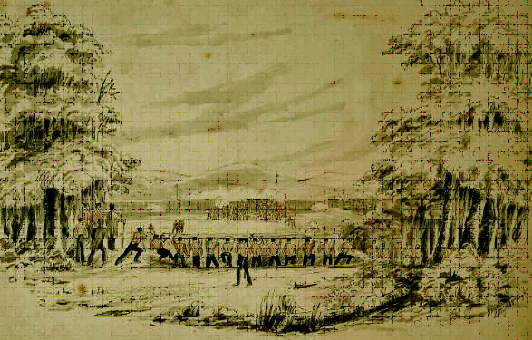
Repulse of the British storming party at Ohaeawai by John Williams, 1 July 1845. Permission of the Alexander Turnbull Library, Wellington, New Zealand, must be obtained before any re-use of this image. Ref:: A-079-030
The British were forced to retreat but by this time more than 100 soldiers had been killed and wounded. Lieutenant Free recalls that “twenty-one men were shot in the charge, including our Captain, Grant, an officer for whom we had a great liking”. Others, such as Lieutenant Philpot, were shot as they tried in vain to scale the pa’s outer stockade. Conversely, few if any of Kawiti’s men were killed. As noted by Lieutenant Free, they could not be seen:
“They were all safely hidden in their trenches and pits, poking the muzzles of their guns under the foot of the outer palisade ”.
This was not the first time that trenches had been used to counter the fire-power of an attacking army. Trenches had been used on at least two previous occasions – by Frederick the Great at Bunzelwitz in 1761 and again by the Duke of Wellington at Torres Vedras in 1810. However, the type of artillery used at these battles was probably a lot older than the guns, cannons and rockets that the British brought to bear on Ohaeawai. Furthermore, the “pits” that Lieutenant Free refers to were later found to be underground compartments reinforced by beams of timber, earth, and stones to render them shell-proof. It appears that the ingenious Kawiti had independently invented the anti-artillery bunker, thus making Ohaeawai; ‘a possible world first in military engineering ’.
Ohaeawai pa is now a churchyard but military engineers and artists were able to observe the pa firsthand following Kawiti’s abandonment of it. A number of diagrams were drawn up, including the following adaptation.

The perimeter of the pa was surrounded by a ‘light fence’ or pekerangi which was designed to slowdown the British advance in much the same way that barbed wire would later be used during World War One. While the pekerangi was light and flimsy, the inner palisade was literally impenetrable. According to one eye-witness, it was made of whole trees and it rose some four metres above the ground, thus making it impossible to scale without a ladder. But it was the addition of ‘flanking angles’ that made this inner palisade so effectively devastating. These flanking angles resulted in many men falling, particularly on the Western flank where; “bullets were poured into them from a small bastion (to the left of the diagram) ”.
Like the pa’s inner palisade, it’s trenches were cleverly engineered and probably a New-World first. According to Col Cyprian Bridge, the main trench was about six feet deep and had ‘firing steps’ carved into it. These steps made it possible for Kawiti’s men to stand upright and fire through loopholes at the base of the stockade. Furthermore, his men were able to move around the pa’s inner parameter by way of a ‘communication trench’ which was connected to the main trench by a number of smaller ones.
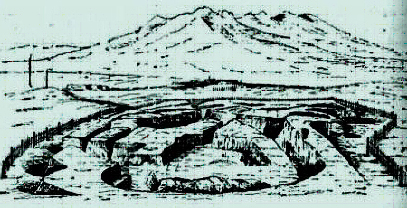
A Sketch of the Paterangi entrenchment by Captain E Brooke shows the type of trench system innovated by Kawiti at Ohaeawai in 1845 (Cowan 1955, p.344)
The pa’s anti-artillery bunkers were also novel as similar dugouts were not used until the American civil war – some 26 years later. Referred to as rua, these underground “pits” could accommodate between 15 and 20 men. They allowed Kawiti’s fighters to remain relatively unharmed and few if any of them were killed during the actual bombardment. In the words of one veteran; “We were safe underground when the big guns began to hurl their mata-purepo at us ”.
Ruapekapeka: The Bats Net
In the weeks following Ohaeawai, Heke began writing letters to the British governor calling for peace – a move that appears to have angered Kawiti; “I expected when you took up arms that you would go out to catch the fish of the deep”, he told Heke, “now, only in the shallows, you are calling out for peace ”. Whether the politically savvy Heke was seeking peace or simply buying more time is uncertain. However, while Heke’s peace negotiations were going on, Kawiti was engineering a new fortification near his hometown of Kawakawa. More than four metres high and 150 x 70 metres in diameter, the effort that went into constructing this massive fortification was remarkable for the times:
“Tools and implements from Kororareka [Russell] were brought to the spot for the construction of this fortress. Large puriri trees were felled, and the trunks were used to form the palisades. These logs were erected high enough to prevent scaling by the enemy. Sunk deeply into the ground they formed a line outside the inner trenches so that they could not be pulled down with ropes. A front line of trenches (‘parepare’) was dug outside the palisades and connected to the inner trenches by alleyways… Deep pihareinga, or dugouts with narrow circular entrances at top, gave access to shelters. These caves looked like calabashes buried underground… The occupants could sleep in comparative safety from the firing which went on overhead. In the event of a surprise attack however, these ruas, or as they have been aptly called, ruapekapeka (bats’ nests) could become veritable mantraps ”.
Aptly named “Ruapekapeka” (The Bats Nest) in honour of its cleverly engineered bunkers, the pa was almost complete when Heke’s peace talks finally broke down. The British had wanted compensation in the form of land but this was unacceptable to both men, particularly Kawiti; ‘No; let us fight on, he told Heke, if they want our lands, they can come and take them when we are dead’. Similarly, in reply to the British Governors’ demand that he yield a portion of his land to them, Kawiti wrote:
“Sir you are very desirous to get my land. I shall be equally desirous to retain it for myself. This is the end of my speech. It ceases here. From me Kawiti ”.
With peace no longer an option and land compensation out of the question, the British began to prepare for another battle – this time at Kawakawa with the intention of taking Ruapekapeka. Having had ‘hard experience’ of Kawiti’s military abilities, they put together a formidable force – more than 1300 troops from all over the empire, including sailors and artillerymen from the East India Company; “This little army was supported by five warships and several transports…three 32-pounders, one eighteen-pounder, two twelve-pounder howitzers, and seven lighter pieces ”.
The British began their bombardment of Ruapekapeka on the 1st of January 1846. For ten days Kawiti’s men hunkered down in the safety of their ‘Bats Nests’ while the British bombardment went on overhead. However, the noise of the gunfire was unbearable and as noted by one Maori veteran; “the big guns were preventing them from getting any sleep ”. Such was the ferocity of the British bombardment, Heke suggested that they abandon the pa; “You are foolish to remain in this pa to be pounded by cannon balls”, he told Kawiti, “Let us leave it. Let the [British] soldiers have it, and we will retire into the forest and draw them after us, where they cannot bring the big guns ”.
Heke and a number of men abandoned Ruapekapeka but Kawiti was unwilling to give up his pa without a fight. Needless to say, he remained in the pa with eleven of his best fighters. However, when the British bombardment had ceased and they finally decided to storm the pa, Kawiti and his men were sleeping below and ill-prepared for a fight:“When the pa was entered the soldiers set up a great shout, which awakened Kawiti; So he and his men fired a volley, and then loaded again and fired a second volley, which was as much as he could do. Then they ran away and joined Heke at the rear of the pa, where he called aloud to Ngapuhi to fight and not allow his pa to be taken without a battle ”
Sadly for Kawiti, Ruapekapeka had already been taken “without a battle”. In fact, it was the British who ended up using its cleverly designed trenches and palisades, firing through loopholes at Kawiti from inside his own invention. As noted by one observer, the fortunes of the two warring parties literally swung to opposite poles, with Kawiti and Heke striving to capture Ruapekapeka and the British fighting to keep it. Their attempt to capture it, however, proved as futile as the British attempt to capture Ohaeawai. Furthermore, when the two leaders ordered their men to “fall back”, the British were not lured into the bush to be ‘picked off’ as Heke had hoped, and although they escaped to fight another day, the British were able to claim a somewhat ‘hollow’ victory.

Ruapekapeka, taken possession of on 11 January 1846 – at noon. Drawn by Lance Sergeant Williams, 58th Regt from a sketch by Lt Col Wynyard C. B . Permission of the Alexander Turnbull Library, Wellington, New Zealand, must be obtained before any re-use of this image. Reference Number: E-320-f-010
Global Exposure of the Kawiti Model
Although Kawiti was unaware of it at the time, Ruapekapeka was one of the most advanced fortifications ever constructed – at least in this part of the world. In fact, Kawiti’s defensive innovations were not dismissed lightly by military leaders and engineers. It is said that after inspecting Ruapekapeka, Colonel Henry Despard commented on its originality stating:
“The extraordinary strength of this place, particularly in the interior defence, far exceeded any idea that could have been formed of it ”
Despard was referring specifically to Kawiti’s ‘Bats Nests’ and reinforced tunnels – the anti-artillery bunkers that he had invented at Ohaeawai and perfected at Ruapekapeka. Nonetheless, Despard was not the only admirer of Kawiti’s engineering feats. Lieutenant Henry Balneavis, the 58th Regiments’ “Acting Engineer”, took detailed drawings of Ruapekapeka. The above drawing clearly outlines the shape and design of this ‘state-of-the-art’ fortification, with some forty or more internal and external “caverns” clearly marked (i.e., Bats Nests’).
Indeed, the British military so admired Ruapekapeka that they made not one but two models of it. Based on the Ohaeawai and Ruapekapeka fortifications, the first model was made by Lieutenant-Colonel Wynyard and sent to the Royal United Services Institute in London – an institute set up in 1831 to study naval and military science. Commenting on this model in an 1850 edition of Auckland’s first newspaper, an unnamed journalist wrote:
“Lieutenant-Colonel Wynyard, C. B,. has just completed a model of Kowiti’s pah at Ruapekapeka. In height and thickness of its timbers it surpassed every former stronghold; and [especially] in its interior defences, namely breastworks, ravines, underground chambers, stockades… It will serve as another means of explaining ‘the check’ to which the arms of England were subjected – to show that even British valour cannot overcome such powerful defences ”.
The second model was made by Lieutenant Balneavis and received even more exposure when it was displayed at the Great Exhibition of World Industry at Crystal Palace in 1851. In his book entitled “The Life and Times of Sir George Grey” (1892), William Rees wrote about the Balneavis model, noting that; “Military visitors to the great Exhibition in 1851 were ‘struck’ by the ingenuity and strength displayed” in this model. Rees went on to make special mention of the Wynyard model, which by this time was being studied by military students at the Royal United Services Institute:
“Even yet the student of military fortification finds his interest awakened by another model of the same fortress, presented by Colonel Wynyard to the United Service Museum”.
It is impossible to measure the effect that Kawiti’s inventions had on military thinking of the time, particularly his anti-artillery bunkers. One can only speculate as to whether or not these innovations were later “borrowed” by other nations. However, the Royal United Services Institute had been set up specifically for the purposes of advancing British military technology and the “military visitors” to the Great Exhibition that William Rees refers to had come from all over the globe, including the United States, thus giving the ‘Kawiti model’ worldwide exposure.
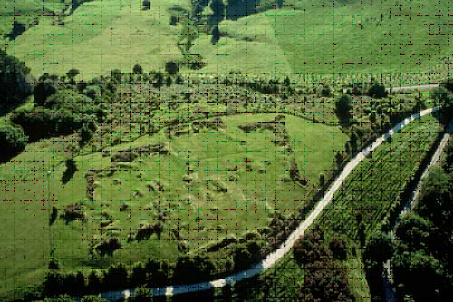
An aerial view of Ruapekapeka as it appears today. The outline of this massive fortification is clearly marked © Department of Conservation, Te Papa Atawhai
Irrespective of his effect on the wider military world, Kawiti’s innovations become a feature of Maori military tactics during the remaining years of New Zealand Wars. Many of the men who had fought at Ohaeawai and Ruapekapeka had come from other parts of the country. Furthermore, messengers took models of Ohaeawai around the country and back to their tribal jurisdictions. During the 1860s, his firing trenches, communication trenches, double palisades, pekerangi, firing loopholes, flanking angles, reinforced tunnels, and anti-artillery bunkers were replicated in fortifications throughout the nation. “Borrowing” from Kawiti’s success at Ohaeawai, indigenous New Zealanders won numerous battles against their British foe, despite the fact that they were greatly outnumbered and only part-time soldiers.
Following the New Zealand Wars, the name Te Ruki Kawiti became increasingly obscure – his engineering feats and Ruapekapeka were sadly forgotten, with lesser men of his generation receiving far more kudos. However, on February the 16th 2008, after more than 150 years of obscurity, Te Ruki Kawiti’s engineering achievements were finally honoured. Ruapekapeka pa, his magnum opus, was recognised by the Institution of Professional Engineers of New Zealand (IPENZ) as a national site of engineering significance. Today, Ruapekapeka pa stands alongside other important engineering icons such as the Auckland Harbour Bridge and the Hamilton jet unit. Te Ruki Kawiti is once again being remembered as an outstanding Maori leader and innovative New Zealander.
Te Takuake a Kawiti
After the battle for Ruapekapeka, Te Ruki Kawiti did not pursue his war against the British. Instead, he joined Hone Heke in making peace with them. It was a reluctant peace accord – not forced upon them by the British but by certain factions in their own tribe. Indeed, British success at Ruapekapeka had not been due to their military superiority or heavy artillery. It had been due to the support and intelligence that they had received from certain Ngapuhi factions. These factions were loyal to the British Crown and opposed to Kawiti and Heke’s war in the North. They had been present at Ohaeawai and they had been instrumental at preventing another British defeat at Ruapekapeka. As a senior Ngapuhi figure, Kawiti greatly lamented his tribes disunity and in particular, its failure to support him and Heke. His grief and disappointment are clearly evident in the following extract from his poem; “Te Takuake a Kawiti”, which he composed after the battle :
The sorrow of love wells up within me,
strikes at my heart strings for the people who have
turned away to find their shelter under the
Queen and have raised weapons of slaves to
set upon the tattoo of my skin, the spirals
sculptured on my nose. Oh my many friends,
why forsake me to become first-slain in this battle?I thought this a war for all, war of men
bound together, a Ngapuhi war, war of old
man Rahiri, war of Kaharau, to be baptised
to the rites of battle, the ceremonial of
Karakawhati, before the shrine of war,
for the hiding of men in the great night of Rehua…I perceive now holiness in the body,
holiness in the land, as I look up
to the four winds of heaven,
Ngaitai arrives with the hidden mere,
from the western seas—the male child—
from the great ocean currents, mighty
surges beyond Mapuna, resounding the roar
of the ever moving tide crashing upon the land.Let the great calm spread through Hokianga
springing from Panguru and Papata,
mountains, heavy with tales, in the west.
The sacred tide flows, crossing the sky,
the current bearing the albatross, turning the
warriors’ boats to the war up-flung, the war
out-spread, the war of kinsmen of Ngapuhi.
So let the war, brought here from the sea
enter Ngapuhi of a hundred folds.
I shall never cease to fight my kinsmen
until I taste the driving sleet of death.
Only then shall I cease to fight my kinsmen
for the great tree of Tane will then lie low.
Kawiti died at Waiomio, near Kawakawa, on the 5th of May 1854 still lamenting the disunity of his people. While the meeting house and marae complex at Waiomio Caves are his memorial, Ruapekapeka and his complex trench and bunker systems are his legacy. Te Ruki Kawiti’s life touched so many epochs in early New Zealand history – the pre-European period; the musket wars of the early eighteen hundreds; the nations’ “moral and technological revolution”; the Treaty of Waitangi; and the New Zealand Wars of which he was an instrumental part even after his death. Te Ruki Kawiti was a tohunga from an earlier generation; a Maori warrior and in particular, an indigenous engineer of ingenious warfare. He was not only a great military leader and strategist but also one of this nation’s earliest heroes whose ideas and innovations may have made more than just a ripple on the world and changed the course of history.
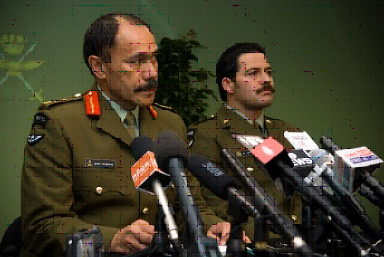
Modern-day Maori Chief and Warrior: Former Chief of the New Zealand Defense Force, Jerry Mateparae (Left) and SAS soldier Willie Apiata VC who received world-wide attention in 2009 for his heroics in Afghanistan © NZ Army Ngati Tumatauenga
This story has been peer-reviewed by David Green, History Group, Ministry for Culture and Heritage
Bibliography
Belich, James (1986). “The New Zealand Wars and The Victorian Interpretation of Racial Conflict”. Auckland University Press, Auckland, New Zealand
Buick, Thomas Lindsay (1914). “The treaty of Waitangi: how New Zealand became a British colony”. Mackay, Wellington New Zealand.
Buick, Thomas Lindsay (1976). “New Zealand’s first war, or, The rebellion of Hone Heke”. Capper Press, Christchurch New Zealand.
Cowan, James (1955). “The New Zealand Wars : a history of the Maori campaigns and the pioneering period”. Government Printer, Wellington, New Zealand
Daily Southern Cross (1850). “Ruapekapeka”. Volume V, Issue 362, 17 December 1850, Page 4
Graham, James (2010). “Kawiti the Master Engineer and the Northern War”. www.HistoryOrb.com online, 2002 available at: http://www.historyorb.com/nz/kawiti.shtml
Graham, James (2010). “The Battle for Kawiti’s Ohaeawai Pa” www.HistoryOrb.com online, 2002 available at http://www.historyorb.com/nz/ohaeawai.shtml
Hart, H. G (1850). “The New Zealand Annual Army List for 1850” John Murray Albemarle Street, London
Kawiti, Tawai (1956). Heke’s War in the North”. Te Ao Hou, The New World, No 16, October 1956.
‘Kawiti, Te Ruki – Biography’ (2010), from the Dictionary of New Zealand Biography. Te Ara – the Encyclopaedia of New Zealand http://www.TeAra.govt.nz/en/biographies/1k4/1
Maning, F. E (1863). “History of the war in the North of New Zealand against the chief Heke in the year 1845” (Note: Written by F. E. Maning through the eyes of a participant on Kawiti and Heke’s side). Geo. T. Auckland, New Zealand
Mill, John Stuart (1848). “The Collected Works of John Stuart Mill, Volume III – Principles of Political Economy Part II. Online Library of Liberty; http://oll.libertyfund.org/?option=com_staticxt&staticfile=show.php%3Ftitle=243&chapter=7193&layout=html&Itemid=27
Signing the Treaty; URL: http://www.nzhistory.net.nz/politics/treaty/making-the-treaty, (Ministry for Culture and Heritage), updated 1-Sep-2010
Owens, J. M. R (1987). “New Zealand before Annexation” in Oliver, W. H & Williams, B. R (1987) edition. “The Oxford History of New Zealand”. Clarendon Press; Wellington; New York: Oxford University Press
Petrie, Hazel (2006). “Chiefs of industry: Maori tribal enterprise in early colonial New Zealand”. Auckland University Press, Auckland, New Zealand.
Rees, Williams. Lee (1892) “The Life and Times of Sir George Grey”, K.C.B. London: Hutchinson & Co., 25, Paternoster Square. Printed by J. S. Virtue and Co., Limited,
City Road
Salmond, Anne (1997). “Between worlds : early exchanges between Maori and Europeans, 1773-1815”. Viking, Auckland, New Zealand
Signing the Treaty, URL: http://www.nzhistory.net.nz/politics/treaty/making-the-treaty/signing-the-treaty, (Ministry for Culture and Heritage), updated 1 September 2010
Sinclair, Keith (1996). “A history of New Zealand”. Cox & Wyman Ltd, Great Britain 1986
Te Ao Hou, The New World (1956) Published Quarterly for the Maori Purposes Fund Board by the Maori Affairs Department. No 16 (Vol. 4)
Thompson, Arthur S. MD (1859). “The Story of New Zealand, Past and Present – Savage and Civilised” John Murray Albemarle Street, London
Waitangi Tribunal Te Ropu Whakamana I Te Tiriti O Waitangi; The Treaty of Waitangi Past and Present; http://www.waitangi-tribunal.govt.nz/resources/school_info/resourcekitsforschools/thesigningofthetreatyofwaitangi.asp
End Notes
1. Mill, Chapter XVII
2. Petrie, p.32 & 39
3. Sinclair; Owens; Petrie
4. Owens; Petrie
5. Petrie, p.56
6. Sinclair, p.42
7. Belich
8. Owens
9. Sinclair, p.40
10. Owens, p.53
11. Maning, p.238
12. Owens
13. Buick 1926, p.46
14. Waitangi Tribunal
15. Buick 1914, p.61-62
16. Ibid
17. Ibid
18. Ministry for Culture and Heritage
19. Buick 1926, p.57
20. Ibid, p.33
21. Te Ao Hou, p.39
22. Maning, p.226
23. Ibid, p.225
24. Ibid, p.225
25. Buick 1926, p.89
26. Te Ao Hou, p.40
27. Belich
28. Maning p.239
29. Ibid
30. Belich
31. Maning, p.267
32. Cowan, p.65
33. Ibid, p.66
34. Belich
35. Cowan, p.66
36. Ibid, p84
37. Te Ao Hou, p.41
38. Ibid p.42
40. Buick 1926, p.211
41. Belich
42. Maning, p.280
43. Ibid
44. Ibid p.281
45. Cowan, p.86
46. Daily Southern Cross
47. Te Ao Hou, p.44







